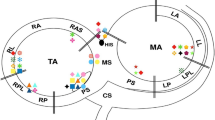Abstract
Background
Recent studies have shown that the pathogenesis of accessory connections (AC) formation may have a genetic component.
Objective
The purpose of the study was to examine whether AC location differs by gender in a large cohort of patients with AC undergoing radiofrequency ablation (RFA) in two Israeli electrophysiology (EP) laboratories.
Methods
All consecutive patients who underwent RFA of single ACs in Tel Aviv Sourasky Medical Center between 1992 and 2009 (n = 574) as well as the first consecutive 230 patients who underwent RFA in Sheba Medical Center between 1992 and 2001 were included in this study.
Results
The 804 patients in the two centers included 511 males (63.6 %) and 293 (36.4 %) females, mean age 34 + 16 years old. The AC was located in the left free wall, posteroseptal, right free wall, right anteroseptal, and in other areas in 57.8, 22.8, 9.3, 7 and 3.1 % of patients, respectively. The anatomical AC distribution was similar in the two EP laboratories. A right free wall location was more frequent in females (13 %) than in males (7.2 %; p = 0.008). A right anteroseptal location was more frequent in males (8.4 %) than in females (4.4 %) (p = 0.043). The left free wall and posteroseptal locations were similarly encountered in males (58.1 and 23.1 %, respectively) and in females (57.3 and 22.2 %, respectively).
Conclusions
In our Israeli population, females more commonly have right free wall ACs and males more commonly have right anteroseptal ACs. These findings support the possible role of a genetic component in the pathogenesis of AC formation.
Similar content being viewed by others
References
Guize, L., Soria, R., Chaouat, J. C., Chrétien, J. M., Houe, D., & Le Heuzey, J. Y. (1985). Prevalence and course of Wolf–Parkinson–White syndrome in a population of 138,048 subjects. Annales de Medecine Interne (Paris), 136(6), 474–478.
Dunnigan, A. (1986). Developmental aspects and natural history of preexcitation syndromes. In D. G. Benditt & D. W. Benson Jr. (Eds.), Cardiac preexcitation syndromes: origins, evaluation, and treatment (pp. 21–29). Boston: Nijhoff.
Ehtisham, J., & Watkins, H. (2005). Is Wolff–Parkinson–White syndrome a genetic disease? Journal of Cardiovascular Electrophysiology, 16(11), 1258–1262.
Gollob, M. H., Green, M. S., Tang, A. S., Gollob, T., Karibe, A., Ali Hassan, A. S., Ahmad, F., Lozado, R., Shah, G., Fananapazir, L., Bachinski, L. L., & Roberts, R. (2001). Identification of a gene responsible for familial Wolff–Parkinson–White syndrome. The New England Journal of Medicine, 344(24), 1823–1831.
Hsu, J. C., Tanel, R. E., Lee, B. K., Scheinman, M. M., Badhwar, N., Lee, R. J., Tseng, Z. H., Olgin, J. E., & Marcus, G. M. (2010). Differences in accessory pathway location by sex and race. Heart Rhythm, 7(1), 52–56.
Gallagher, J. J., Pritchett, E. L. C., Sealy, W. C., Kasell, J., & Wallace, A. G. (1978). The preexcitation syndromes. Progress in Cardiovascular Diseases, 20, 285–327.
Lee, P. C., Hwang, B., Chen, Y. J., Tai, C. T., Chen, S. A., & Chiang, C. E. (2006). Electrophysiologic characteristics and radiofrequency catheter ablation in children with Wolff–Parkinson–White syndrome. Pacing and Clinical Electrophysiology, 29(5), 490–495.
Griggs, L. H., Chapman, C. J., & McHaffie, D. J. (1986). Inheritance of atrioventricular conduction time in Tokelau Islanders. Clinical Genetics, 29(1), 56–61.
Arad, M., Moskowitz, I. P., Patel, V. V., Ahmad, F., Perez-Atayde, A. R., Sawyer, D. B., Walter, M., Li, G. H., Burgon, P. G., Maguire, C. T., Stapleton, D., Schmitt, J. P., Guo, X. X., Pizard, A., Kupershmidt, S., Roden, D. M., Berul, C. I., Seidman, C. E., & Seidman, J. G. (2003). Transgenic mice overexpressing mutant PRKAG2 define the cause of Wolff–Parkinson–White syndrome in glycogen storage cardiomyopathy. Circulation, 107(22), 2850–2856.
Author information
Authors and Affiliations
Corresponding author
Rights and permissions
About this article
Cite this article
Birati, E.Y., Eldar, M. & Belhassen, B. Gender differences in accessory connections location: an Israeli study. J Interv Card Electrophysiol 34, 227–229 (2012). https://doi.org/10.1007/s10840-012-9683-4
Received:
Accepted:
Published:
Issue Date:
DOI: https://doi.org/10.1007/s10840-012-9683-4




